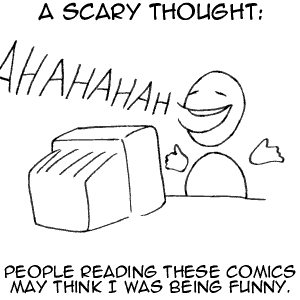What tragicomics are About
tragicomics is a collection of little observations about how life is the opposite of fun. Keep in mind that life is not only like this, but it always is.
The comics are about real life incidents and observations. Some are more subjective than others. Some are openly metaphorical. Some are intensified to emphasise ridiculousness, but fewer than you would think. I sometimes added a character to a situation in order to put internal monologue into dialogue.
Some comics are about recent events in my life. Others relate to things of the past, often of my teenage years. Most comics tell things I needed to get off my chest.
About the Update Schedule
tragicomics have been on hiatus since 2010. Before that they were regularly updated at Wednesdays, UTC 15:00.
Sometimes there were irregular updates on special occasions. You can keep track of tragicomics via Piperka or the tragicomics RSS feed.
About the Technology
tragicomics are browsable through a custom PHP script. It currently uses an index file in XML format, which probably is terribly ineffective compared to making use of a MySQL database.
Except for Ye Olde tragicomics, the comic strips are SVGs, usually drawn in Inkscape and cleaned up by hand.
Textual fallback content for visually impaired readers and for search engines is generated from transcripts written in an XML format. Newer comics have their transcripts embedded inline in the SVG files. The separate transcript files of older comics have the extension .ts.xml, in case you’re interested in having a look at them.
Because the Microsoft Internet Explorer has many quirks with object tags, I use a Javascript named IEFixObjectTags to make the embedded images scale correctly. IEFixObjectTags is distributed under the S-BSD License.
Ye Olde tragicomics-Technology:
Most of the old comics are PNGs with a color palette of only six grey scales, equidistantly spanning from black to white. For high contrast black and white drawings this quantization—without dithering—allows for very good compression (small file size) while still providing good enough anti-aliasing. When gradients or colors are used, I apply other palettes or other file formats.
To quantize and compress one of the images from the command line I used these commands:
mogrify +dither -map "grays6.png" -strip "comic.png"
optipng "comic.png"
Here’s the palette for GIMP, but you can easily create it yourself. The hexadecimal RGB values are:
- 000000
- 333333
- 666666
- 999999
- cccccc
- ffffff
Occasionally I’ve put comics in SVG format online. I’ve usually been doing the layout and lettering in SVG anyways, but then rasterised them with Apache Batik, because they weren’t really scalable anyways due to the use of embedded raster graphics. WJWW is a typical example, except that it contains drawings and a photographic picture, so I figured I could compress it better if I don’t render it into one raster graphic. I used to mostly code the SVGs by hand back then.
The paths for the characters and for the trails in Have a Lucky New Year 2009 were drawn with my own FeSVG Path Data Editor in Opera.
